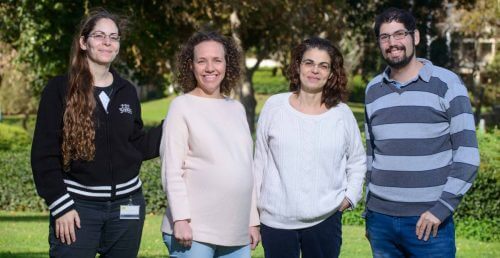
When a mouse is interested in a mouse, it shows this first of all with its snout - and goes on a journey of investigation and sniffing. Many studies have confirmed that pheromones, the scents that animals secrete, play a role in communication and attraction between the sexes, but until now it was not clear how the neural mechanisms involved in this work. A new study by Weizmann Institute scientists, SRecently published in the scientific journal Cell reports, revealed that when male mice do not receive a specific neural reward, they lose interest, and stop showing sexual preference towards females. These findings illuminate the operation of a basic evolutionary mechanism which is responsible for the survival and continuity of the species.
Mammals and other animals activate, besides the nose, another olfactory organ, known as Jacobson's organ; A degenerated and inactive version of this organ also exists in humans. Unlike the nose, Jacobson's organ is mainly responsible for receiving pheromones. Prof.'s lab Tali Kimchi, in the Department of Neurobiology at the Weizmann Institute, specializes in research on genetically engineered mice in which this olfactory organ does not function. Bprevious researches Prof. Kimchi and her research partners showed that male mice without an active Jacobson's organ exhibit sexual behavior that does not distinguish between males and females, and do not express aggression towards other males. On the other hand, transgenic females exhibit male sexual behavior - they sniff potential partners, and even try to mount them while making typical pelvic movements.
However, in the laboratory's research from 2016, it was discovered that even in the absence of an active Jacobson's organ, the transgenic mice can definitely distinguish between males and females, yet exhibit sexual behavior that does not distinguish between them. After being negatively conditioned to female pheromones, these mice became withdrawn from females, but continued to exhibit sexual behavior towards males. Following the findings, the researchers hypothesized that the genetically engineered mice are not "adequately rewarded", and therefore have no motivation to show a special interest in females. In other words, without the sensory input of the pheromones in the Jacobson's organ of the transgenic mice, the pleasure center in their brain, identified with the area known as the nucleus accumbens, is not activated, and in the absence of the reward, the sexual response is also absent.
"The fact that sexual stimulation activates the reward system is not new in itself, but the findings show that this activation is essential and even necessary for the existence of the sexual response"

Through three experiments led by the research student at the time, Dr. Yamit Beni-Shafer, the present study confirms this hypothesis. First, the researchers established the activation of the "pleasure center" in the brain's reward system when exposed to female pheromones. The researchers showed that in non-transgenic mice the levels of the neurotransmitter dopamine increased in the nucleus accumbens after being placed in a female cage, while in the transgenic mice there was no corresponding increase in dopamine levels. From the analysis of the mice's behavior, it emerged, as expected, that the non-transgenic mice exhibited sexual behavior towards females and expressed aggression towards males, while the transgenic mice showed almost no aggression, and expressed sexual behavior towards both males and females.
In the second stage, the researchers tested whether manipulation of the "pleasure center" would create a sexual preference towards females in mice whose Jacobson's organ is inactive. To this end, the researchers turned to optogenetics - a method that allows you to "turn on" and "turn off", with great precision, different types of cells in the brain, by illuminating them with a tiny beam of light. In fact, the researchers bypassed the dysfunctional pheromone absorption mechanism, and directly activated the pleasure centers of the mice. While activating the dopaminergic pathways in the core of the nucleus accumbens, the researchers exposed the mice to females that were in a perforated cage, thus creating a coupling between the exposure to the females and the specific optogenetic stimulation of the reward system. The mice were then subjected to a series of behavioral tests from which a clear picture emerged: the mice showed a sexual preference for females similar to non-transgenic mice. However, in all other males, the transgenic mice continued to exhibit sexual behavior without aggression.
After the connection between sexual preference and activation of the nucleus accumbens was established, the scientists turned to understand the neural pathway more deeply. To do this, they injected a dopamine D1 receptor blocker into the nucleus accumbens of non-transgenic mice. By blocking the specific neural pathway, the mice's sexual preference towards females was also blocked. Moreover, this behavior of non-transgenic mice was preserved even about two weeks after the injection. "The fact that sexual stimulation activates the reward system is not new in itself," explains Dr. Nega Zilka. "But the findings show that this activation is essential and even necessary for the existence of the sexual response." Dr. Yael Lavia-Avnon and research student Nadav Bezalel also participated in the study.
#Science_Numbers
In response to exposure to an infected female, dopamine levels in the nucleus accumbens of non-transgenic male mice increased by approximately 80%.

3 תגובות
The site became unreadable on the phone. The "flash" at the top of the page jumps the text of the entire article.
Too bad..
Okay, so how do you activate the Jacobson's organ in humans? And how do you add opto-genetic control? And what pheromones do we release - that are not absorbed by the dysfunctional organ? And what signals are we actually missing? Or maybe some people don't miss them that much?
exciting!